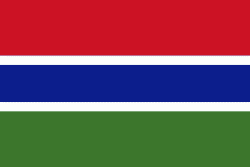Serekunda
Serekunda (proper: Sayerr Kunda or Sere Kunda, sometimes spelled Serrekunda) is the largest urban centre in The Gambia. It is situated close to the Atlantic coast, 13 km south-west of the capital, Banjul, and is formed of nine villages which have grown together into a larger urban area.
Sayerr Jobe, the founder of Serekunda, was a 19th-century lamane originally from the Sine-Saloum region of Senegal. He migrated to the Gambia in the mid 19th Century and is believed to have initially settled around Jinack Island in Banjul, before relocating to the southern bank of the country (near Sukuta) where he established Serrekunda.
Serekunda means "home of the Sayer [or Sayerr] family" and is named after its founder, Sayerr Jobe. The name Serrekunda (or "Sere Kunda") is a Mandinka corruption of the name Serrereh — denoting the Serer people in Mandinka, as the Mandinka people of Sabiji believed that Sayerr Jobe (the founder of Sererkunda ) and his brother Massamba Koki Jobe/Diop (relative of Lat Dior - King of Cayor and Baol) and the Jobe family in general were members of the Wolof ethnic group. Thus, in the oral tradition of the Mandinkas of Sabaji (of which Serekunda was part), they initially referred to the area with the Mandinka saying: "mbitala serrereh kunda" (I am going to Serer area/country), later shortened to Serreh Kunda (or Serekunda). The word kunda or kundaa is a Mandinka word for place, area, country or compound. In essence, Sere Kunda means Serer country/area made in reference to Sayerr Jobe who was from the Serer Sine-Saloum area, and whom the Mandinkas believed to be of Serer origin. Although born in Serer country, and possessed the Serer title lamane, he was not of Serer origin, but of Lebou origin, as Jobe or Diop is a Lebou surname.
Sayerr Jobe, the founder of Serekunda, was a 19th-century lamane originally from the Sine-Saloum region of Senegal. He migrated to the Gambia in the mid 19th Century and is believed to have initially settled around Jinack Island in Banjul, before relocating to the southern bank of the country (near Sukuta) where he established Serrekunda.
Serekunda means "home of the Sayer [or Sayerr] family" and is named after its founder, Sayerr Jobe. The name Serrekunda (or "Sere Kunda") is a Mandinka corruption of the name Serrereh — denoting the Serer people in Mandinka, as the Mandinka people of Sabiji believed that Sayerr Jobe (the founder of Sererkunda ) and his brother Massamba Koki Jobe/Diop (relative of Lat Dior - King of Cayor and Baol) and the Jobe family in general were members of the Wolof ethnic group. Thus, in the oral tradition of the Mandinkas of Sabaji (of which Serekunda was part), they initially referred to the area with the Mandinka saying: "mbitala serrereh kunda" (I am going to Serer area/country), later shortened to Serreh Kunda (or Serekunda). The word kunda or kundaa is a Mandinka word for place, area, country or compound. In essence, Sere Kunda means Serer country/area made in reference to Sayerr Jobe who was from the Serer Sine-Saloum area, and whom the Mandinkas believed to be of Serer origin. Although born in Serer country, and possessed the Serer title lamane, he was not of Serer origin, but of Lebou origin, as Jobe or Diop is a Lebou surname.
Map - Serekunda
Map
Country - The_Gambia
 |
 |
The Portuguese in 1455 entered the Gambian region, the first Europeans to do so, but never established important trade there. In 1765, the Gambia was made a part of the British Empire by establishment of the Gambia. In 1965, the Gambia gained independence under the leadership of Dawda Jawara, who ruled until Yahya Jammeh seized power in a bloodless 1994 coup. Adama Barrow became the Gambia's third president in January 2017, after defeating Jammeh in the December 2016 elections. Jammeh initially accepted the results, before refusing to leave office, triggering a constitutional crisis and military intervention by the Economic Community of West African States that resulted in his removal two days after his term was initially scheduled to end.
Currency / Language
| ISO | Currency | Symbol | Significant figures |
|---|---|---|---|
| GMD | Gambian dalasi | D | 2 |
| ISO | Language |
|---|---|
| EN | English language |
| WO | Wolof language |















